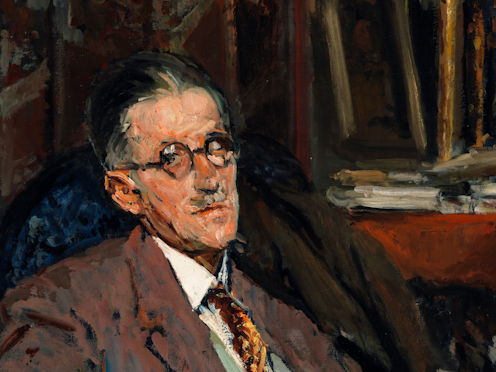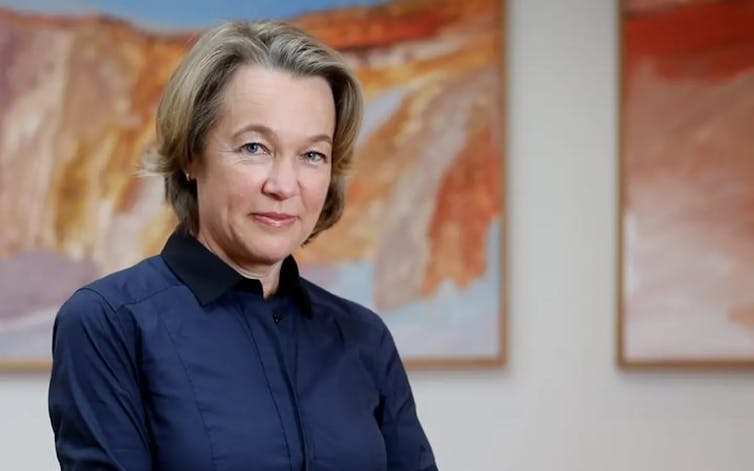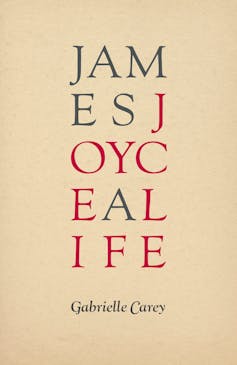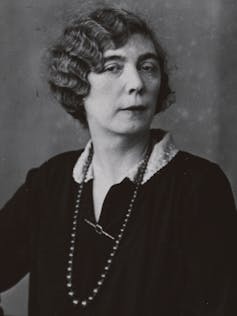
Gabrielle Carey cast a distinctive shadow within Australian writing, one you miss acutely only when it is no longer bodily present, even as elements of her essence remain as words on the page.
She was a writer who brought her own life into writing in ways that challenged ordinary assumptions about the nature of autobiography, since she was not only interested in events or things, but also in ideas – ideas that exist as a state of longing or emotion, as much as they exist as intellectual givens or facts.
Review: James Joyce: A Life – Gabrielle Carey (Arden)
Gabrielle’s way is to cut holes in the fabric of standard forms of literary scholarship that allow her to tunnel through to some otherwise inaccessible idea. Because of this, when one reads her last book, James Joyce: A Life, one is conscious that the voice is telling itself as it tells the tale. In doing so, it forces a sharp light through the events and ideas that surround James Joyce like a beam through a thick fog.
The fog of words around Joyce is now so dense it can be difficult to penetrate. Because of this, many readers are too intimidated to approach his works directly. Carey’s response is to have done with justification, or at least the particular kind of circumlocution scholarship requires when it asks us to cite all the others who have trod this ground before. She does away with any and all footnotes, any and all works cited.
This is not to say Carey’s work is not justified by her own scholarship. On the contrary, she is a deeply knowledgeable scholar of Joyce and it is possible to trace all the references she makes by attending closely to the names mentioned throughout. The choice can be justified, as it allows her to trace lines through the material that are profoundly moving and acutely perceptive.

There are two such lines that help to us feel the person behind Ulysses, Dubliners, A Portrait of the Artist as a Young Man and Finnegans Wake – some of the great masterpieces of any age of world literature.
The first is the idea of a list that is more than just a list: a list that accumulates and opens out, like the mathematical exercise of long division the schoolboy Stephen Daedalus sees unfolding on a page in A Portrait of the Artist as a Young Man.
The second is the idea of life itself, which is more than “a” life, but rather a collective existence that includes, in particular, those you love and that love you, as well as the many selves you promote and hide, and those you have influenced and touched, including readers born after the “life” of the physical person has passed.
More than this, the idea of life also includes the life of Gabrielle Carey the reader, who makes us see things that hurt and delight her. She is a shadow that organises the whole, a shadow whose absence one feels everywhere.
A life in lists
The book announces itself as a list:
“James Augustine Aloysius Joyce was born on 2 February 1882 …”
“When Joyce was five …”
“At six, being near-sighted …”
We are told of Joyce’s love of lists and associations.
As a mature writer, he continued to have a fondness for lists, some of which go on for pages. A list in Finnegans Wake provides a playful self-portrait:
“the wrong shoulder higher than the right, an artificial tongue with a natural curl, not a foot to stand on, a handful of thumbs, a blind stomach, a deaf heart, a loose liver, two fifths of two buttocks, a salmonkelt’s thinskin …”

The lists Carey makes, like those of Joyce, accumulate vertically as they proceed, but open out horizontally, with every listed item carrying associations of its own.
Using the list with stylistic canniness, Carey, rather than becoming lost in endless qualifications and explanations, instead works with deep simplicity. That is, most paragraphs lack a tissue that connects them immediately to that which proceeds or follows. They stand alone, each offering new insights and new bits of information, which we connect intuitively. The effect is clearly intended and powerful. It allows Carey to cover an enormous amount of material in a book that runs to just 130 pages.
There is, however, a shift in the lists as one proceeds. The early pages emphasise the brightness of Joyce’s character as a young boy: “At home his nickname was Sunny Jim because of his happy, easy-going disposition.” In the later chapters, he is wracked by physical pain and emotional despondency.
Joyce’s most famous biographer Richard Ellmann, speaking of the relations between Joyce and Samuel Beckett, who idolised him, wrote that both men “were prone to long silences and their conversations were usually suffused with sadness, Beckett mostly for the world, Joyce mostly for himself”. But Carey shows us with utter clarity how Joyce moves from joy to sorrow not through self-pity, but an accumulation of troubles, many of which involved his relations to his family and his own declining health.

Perhaps because a great biography like Ellmann’s tends to emphasise the triumphal arc that takes someone like Joyce, through his genius, from obscurity to astonishing achievement and influence, one loses sight, somehow, of the person who lived amid the shelter or ruins of that achievement.
Carey’s feat is to allow us to sense the man in all his contingency and awkward vulnerability. Based on a style and a feeling, her own, for the outlines of accumulating events, her story is not so much of a born genius, but someone who was only steps ahead of abject failure for much of his life.
Rather than seeing Joyce the man as cut off from or transcending the world in which he moved, Carey demonstrates how others held him up, carried him the few extra steps he needed to go again and again, to reach something that no one had thought it possible to reach.
She shows how those who held him up were often the women who surrounded him: his mother May, his life’s love Nora Barnacle, his beloved daughter Lucia.
His indefatigable supporter Harriet Shaw Weaver published him and paid him significant sums of money to allow him to write. Dora Marsden, editor of the magazine The Egoist, brought many of his works to the world. Margaret Anderson and Jane Heap, publishers of the Little Magazine in the United States, were charged with and convicted of obscenity for publishing the “Nausicaa” episode from Ulysses; it ruined them financially.
Read more: Friday essay: the wonder of Joyce's Ulysses
It was not only women. Joyce’s brother Stanislaus and his loyal friend Paul Léon, among others, are also there and helping. Carey does not let us forget that without them he could not have become James Joyce. At times, even often, these helping hands suffered for their service.

More than this, Carey allows us to glimpse what is perhaps true of everyone – that is, the person we think of as an individual, “James Joyce”, is in fact composed of people who loved him as much as the egoistic self we like to celebrate. One of the many names of the protagonist of Finnegans Wake is “Here Comes Everybody”.
Joyce is also composed not just of those others, but the places of which he wrote, and in which he lived as he wrote, and the worlds they contained. Glimpsing this in no way diminishes the achievement we habitually attach to a self; rather, it allows us to understand how a life accumulates and spreads in many directions.
From joy to sorrow
Joyce’s suffering was often self-inflicted. He saw the weaknesses of his father, an alcoholic spendthrift, who frittered away a comfortable life for himself his wife and children, to the point where the family was living in poverty, but he also loved and idolised him. From his father Joyce inherited alcoholism, a jaunty disposition, recklessness, and no practical sense of how to manage a household financially.
His alcoholism was driven by the “green fairy” of absinthe (closer to a hallucinogenic than mere hard liquor), until his common-law wife Nora at last made him swap it for mere wine. He would collapse on the streets of Triese and Rome, sleeping propped against lampposts or in doorways when he didn’t quite make it home to Nora, who was busy scrimping his meagre wages to support them and their two young children.
Carey at one point fails to understand why Joyce did not support his talented but highly strung daughter Lucia in her desire to become a professional dancer. She shows that Nora also disapproved of this career choice. For Carey, this parental failure opens the way to Lucia’s future madness, which devastates the family and is one of the primary causes of Joyce’s move from joy to sorrow.
Joyce feared his own madness (diverted into creativity) was the source of Lucia’s. He took his daughter from head doctor to head doctor, some as renowned as Carl Jung, others hideous charlatans, like one Dr Vignes, who prescribed injections of seawater. Yet Lucia continued to deteriorate. She would end her life in an English asylum.
Read more: Lucia Joyce: on Bloomsday, consider this real-life character's enduring and mysterious appeal
Joyce lived a life with Nora that seemingly mixed profound love with utter disregard for her wellbeing, leaving her to carry the heavy burdens of raising children. And yet despite threatening to leave him (or baptise his children against his wishes) again and again, she never failed him. She fiercely defended him from the Ireland she believed had betrayed him through its neglect and contempt for his work.
Joyce’s life, rather than his works, is the main thread of this book, and that life is extraordinarily flawed. It is filled with poverty and the consequences of poverty. When poverty at last abates, due mostly to the generosity of Harriet Shaw Weaver (even more than the succès de scandale of Ulysses), Joyce’s teeth rot through lack of dental care and his eyesight deteriorates catastrophically.
He endures multiple eye operations, performed without anaesthetic, to the point where he can barely see. Like Milton’s daughters, Lucia reads aloud to her father and takes down his dictation. He suffers abdominal pain for years, which quackish doctors attributed to stress, leading to his death in 1941 at the age of 59 from an perforated ulcer, diagnosed too late.
Through all this, one senses the shadow of Gabrielle Carey, watching with affection, at times sadness, at times even disappointment, but also fiercely loyal to the intense feeling that Joyce has summoned within her through the power of his writing.
The book’s themes, almost unbearably, draw us back to her: the struggle with mental illness, the struggle with day to day life, the shadow of the father, the feeling of having failed others. Mostly though, Carey makes us feel that these human things, as painful as they may be, are part of life and touch all our lives, much as we might wish to turn away from them. She makes us see, as Joyce did, what is sacred in the seemingly profane.
Anthony Uhlmann has in the past been funded for research on James Joyce and others by The Australian Research Council.
This article was originally published on The Conversation. Read the original article.







